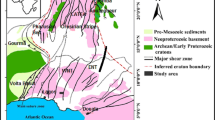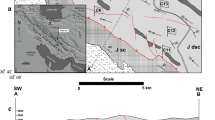Abstract
This paper considers the basic principles of the strain analysis method based on the analysis of antitaxial regeneration fibrous fringes around linear rigid inclusions in a low-viscosity rock matrix. This method has been developed for pressure shadows composed of fibrous minerals, whose orientation is controlled by the major elongation direction rather than the orientation of rigid inclusions. This approach is applicable only for rocks exposed to uniform coaxial straining. The strain ellipse is calculated in two ways: for three variably oriented strain markers, it is calculated using Mohr’s circles, and for numerous strain markers by average body ellipse. The strain ellipsoid is calculated using the parameters of a few strain ellipses calculated with three and more non-parallel planes. This paper provides the data on the method testing in reference sites of Dora–Pil’ ore field in the Upper Indigirka district and Vangash area in the Yenisei Range. Regeneration fibrous fringes around fragments of fern fossils and linear rutile metacrystals were used as markers. The results of strain analysis obtained for the reference sites in the Upper Indigirka district made it possible to describe the signs of variable strain stages of developing strike-slip zones making up the Adycha–Taryn Fault Zone. Sublatitudinal ore-bearing strike-slip zones are characterized by a subvertical orientation of the elongation axes X of elongated strain ellipsoids, which are subperpendicular to quartz–carbonate veins and slope kink zones. NW-trending strike-slip zones are characterized by subhorizontal orientation of the Z shortening axes of flattened strain ellipsoids, which are subparallel to the normals of quartz–carbonate veins and veinlets. The results of strain analysis obtained for reference sites in the Vangash area made it possible to describe the thrust strain environment following the metamorphism stage and to reveal specific features in the formation of the strain textures of ore-bearing rocks based on their rheological properties.
Similar content being viewed by others

References
G. Yu. Akimov, A. V. Kryuchkov, T. L. Krylova, and A. A. Sidorov, “The Taryn vein–disseminated ore deposit: A new type of gold mineralization in the Verkhnyaya Indigirka Region, Yakutia,” Dokl. Earth Sci. 397, 737–742 (2004).
N. Yu. Vasil’ev and A. O. Mostryukov, “Tectonophysical reconstruction of noble metal settling conditions in dunites of a layered massif,” in M.V. Gzovskii i razvitie tektonofiziki, Ed. by Yu. G. Leonov (Nauka, Moscow, 2000), pp. 281–295.
V. A. Vernikovsky and A. E. Vernikovskaya, “Tectonics and evolution of granitoid magmatism in the Yenisei Ridge,” Russ. Geol. Geophys. 47, 32–50 (2006).
A. V. Vikhert, “Estiamtion of rock deformation from grains of arbitrary shapes,” Geotektonika, No. 1, 59–68 (1988).
V. N. Voytenko, A. K. Khudolei, and I. F. Gertner, “Influence of deformation value on chemical composition of sandstones: A case study of the Talas Alatau greenschist complex, Kyrgystan, in Materialy XXXVII Tektonicheskogo soveshchaniya, Vol. 2: Evoliutsiya tektonicheskikh protsessov v istorii Zemli, Ed. by Yu. V. Karyakin (GEOS, Moscow, 2004), pp. 140–142.
V. A. Galkin, “Stress-analysis in petrostructural studies of rocks,” Vestn. Mosk. Univ. Ser. 4: Geol., No. 4, 35–50 (1992).
M. V. Gzovskii, Main Tectonophysical Issues and Tectonics of the Baidzhansai Anticlinorium (Izd. Akad. Nauk SSSR, Moscow, 1959), Pts. I and II [in Russian].
M. V. Gzovskii, Main Tectonophysical Issues and Tectonics of the Baidzhansai Anticlinorium (Izd. Akad. Nauk SSSR, Moscow, 1963), Pts. III and IV [in Russian].
D. W. Durney and J. G. Ramsay, “Incremental deformations measured by syntectonic crystal growths,” in Gravity and Tectonics, Ed. by K. A. De Jong and R. Scholten (Wiley, New York, 1973), pp. 67–96.
B. N. Imamendinov, V. N. Voytenko, and D. N. Zadorozhnyi, “Structural evolution of pyrites of the Dora-Pil’ gold ore field, East Yakutia,” in Ontogeniya mineralov i ee znachenie dlia resheniya geologicheskikh pricladnykh i nauchnykh zadach (k 100-letiyu so dnya rozhdeniya professora D. P. Grigoreva), Ed. by Yu. B. Marin, M. V. Morozov, and D. A. Petrov (Ross. Mineral. O–vo, St Petersburg, 2009), pp. 60–62.
A. B. Kirmasov, Fundamentals of Structural Analysis (Nauchn. mir, Moscow, 2011) [in Russian].
A. B. Kirmasov, “Strain-analysis of cleavage-affected detrital rocks: Mechanisms and quantitative estimate of deformation,” Vestn. Mosk. Univ. Ser. 4: Geol., No. 6, 12–20 (2002).
A. V. Luk’yanov, “Strain-analysis as a method of quantitative study of tectonic deformations,” in Eksperimental’naya tektonika i polevaya tektonofizika, Ed. by A. V. Chekunov (Nauk. Dumka, Kiev, 1991), pp. 126–131.
Yu. V. Miller, Structure of the Archean Greenschist Belts (Nauka, Leningrad, 1988) [in Russian].
E. I. Patalakha, Tectonofacies Analysis of the Phaerozoic Folded Structures: Substantiation, Techniques, and Application (Nauka, Moscow, 1985) [in Russian].
E. I. Patalakha and T. V. Giorgobiani, Structural Analysis of Linear Folding: A Case Study of the Karatau Ridge (Caledonian Cycle) (Nauka Kaz. SSR, Alma-Ata, 1975) [in Russian].
A. V. Prokop’v, G. N. Gamyanin, A. G. Bakharev, V. V. Alpatov, A. I. Zaitsev, “Tectonics, geodynamics, and metallogeny of the zone of junction and interaction (interference) between the Verkhoyansk fold-thrust belt, Okhotsk terrane, and Kolyma–Omolon microcontinent,” in Rudogenez i metallogeniya vostoka Azii (IGABM SO RAN, Yakutsk, 2006), pp. 141–145.
A. I. Rodygin, Methods of Strain-Analysis: A Textbook (Tomsk. Gos. Univ., Tomsk, 1996) [in Russian].
A. M. Sazonov, A. A. Anan’ev, T. V. Poleva, A. N. Khokhlov, V. S. Vlasov, E. A. Zvyagina, A. V. Fedorova, V. A. Tishin, and S. I. Leont’ev, “Gold ore metallogeny of the Yenisei Range: Geologic-structural position and structural types of ore fields,” Zh. Sib. Fed. Univ., Tekhn. Tekhnol., No. 4, 371–395 (2010).
A. A. Trofimov, Fundamentals of Mining Geometry (Mosk. Gos. Univ., Moscow, 1980) [in Russian].
A. K. Khudolei and S. A. Semiletkin, “Morphology and evolution of folded and fault structures of the Talas Alatau, North Tien Shan,” Geotektonika, No. 1, 84–93 (1992).
V. G. Shakhtyrov, Doctoral Dissertation in Geology and Mineralogy (SVKNII, Magadan, 2009).
V. N. Sholpo, Alpine Geodynamics of the Greater Caucasus (Nedra, Moscow, 1978) [in Russian].
F. L. Yakovlev, V. N. Voytenko, A. K. Khudolei, and A. V. Marinin, “Relationship between shortening strains in the folded domain and competent layer,” in Materialy XXXVI Tektonicheskogo soveshchaniya, Ed. by Yu. V. Karyakin (GEOS, Moscow, 2003), Vol. 2, pp. 325–329.
T. G. Blenkinsop, Deformation Microstructures and Mechanisms in Minerals and Rocks (Springer, Oxford, 2002).
M. T. Brandon and S. Paterson, “Applications of strain: From microstructures to orogenic belts,” Geol. Soc. Am. Today 3, 174–179 (1993).
E. Cloos, “Oölite deformation in the South Mountain fold, Maryland,” Geol. Soc. Am. Bull. 58, 843–918 (1947).
D. G. De Paor, “Strain determination from three known stretches–an exact solution,” J. Struct. Geol. 10, 639–642 (1988).
A. A. De Ronde, R. Heilbronner, H. Stunitz, and J. Tullis, “Localization of deformation and mineral reaction in experimentally deformed plagioclase–olivine aggregates,” Tectonophysics 383, 93–109 (2004).
D. Dunnet, “A technique of finite strain analysis using elliptical particles,” Tectonophysics 7, 117–136 (1969).
E. A. Erslev, “Limited, localized nonvolatile element flux and volume change in Appalachian slates,” Geol. Soc. Am. Bull. 110, 900–915 (1998).
E. A. Erslev and H. Ge, “Least–squares center–to–center and mean object ellipse fabric analysis,” J. Struct. Geol. 12, 1047–1059 (1990).
N. Fry, “Random point distribution and strain measurement in rocks,” Tectonophysics 60, 89–105 (1979).
J. F. Hippertt, “Breakdown of feldspar, volume gain and lateral mass transfer during mylonitization of granitoid in a low metamorphic grade shear zone,” J. Struct. Geol. 20, 175–193 (1998).
A. K. Khudoley, “Structural and strain analyses of the middle part of the Tallasian Alatau ridge (Middle Asia, Kirgiystan),” J. Struct. Geol. 15, 693–706 (1993).
R. J. Lisle, Geological Strain Analysis: A Manual for the Rf/φ' Technique (Pergamon, Oxford, 1985).
R. J. Lisle and D. M. Ragan, “Strain from three stretches–a simple method,” J. Struct. Geol. 10, 905–906 (1988).
G. E. Lloyd and C. C. Ferguson, “Belemnites, strain analysis and regional tectonics: A critical appraisal,” Tectonophysics 169, 239–253 (1998).
M. Markley and S. Wojtal, “Mesoscopic structure, strain, and volume loss in folded cover strata, Valley and Ridge Province, MD,” Am. J. Sci. 296, 23–57 (1996).
N. Nakamura and G. J. Borradaile, “Strain, anisotropy of an hysteretic remanence, and anisotropy of magnetic susceptibility in a slaty tuff,” Phys. Earth Planet. Inter. 125, 85–93 (2001).
W. N. Owens, “The calculation of a best-fit ellipsoid from elliptical sections on arbitrarily oriented planes,” J. Struct. Geol. 6, 611–618 (1984).
C. W. Passchier and R. A. J. Trouw, Microtectonics (Springer, Berlin, 2005).
J. G. Ramsay, Folding and Fracturing of Rocks (McGraw-Hill, New York, 1967).
J. G. Ramsay and M. I. Huber, The Techniques of Modern Structural Geology, Vol. 1: Strain Analysis (Academic Press, London, 1983).
U. Ring and M. T. Brandon, “Ductile deformation and mass loss in the Franciscan Subduction Complex: implication for exhumation processes in accretionary wedges,” in Exhumation Processes: Normal Faulting, Ductile Flow and Erosion, Vol. 154 of Geol. Soc. London, Spec. Publ., Ed. by U. Ring, M. T. Brandon, G. S. Lister, and S. Willett (London, 1999), pp. 55–86.
V. N. Voitenko and I. Yu. Khlebalin, “The finite strain estimation method, based on fibrous quartz orientation in pressure shadows around rigid inclusion in Upper Triassic’s siltstone,” in 9th Meeting of the Central European Tectonic Studies Groups, Ed. by S. Ulrich, O. Lexa, P. Závada, and P. Jerábek (2011), pp. 91–92.
V. N. Voytenko and A. K. Khudoley, “Structural evolution of metamorphic rocks in the Talas Alatau, Tien Shan, Central Asia: Implication for early stages of the Talas–Ferghana Fault,” C. R. Geosci. 344, 138–148 (2012).
Author information
Authors and Affiliations
Corresponding author
Additional information
Original Russian Text © V.N. Voytenko, I.Yu. Khlebalin, V.A. Senotrusov, 2016, published in Geotektonika, 2016, No. 1, pp. 62–80.
Rights and permissions
About this article
Cite this article
Voytenko, V.N., Khlebalin, I.Y. & Senotrusov, V.A. Application of strain analysis to estimate pressure solution processes in regional shear zones. Geotecton. 50, 54–70 (2016). https://doi.org/10.1134/S0016852116010064
Received:
Published:
Issue Date:
DOI: https://doi.org/10.1134/S0016852116010064



